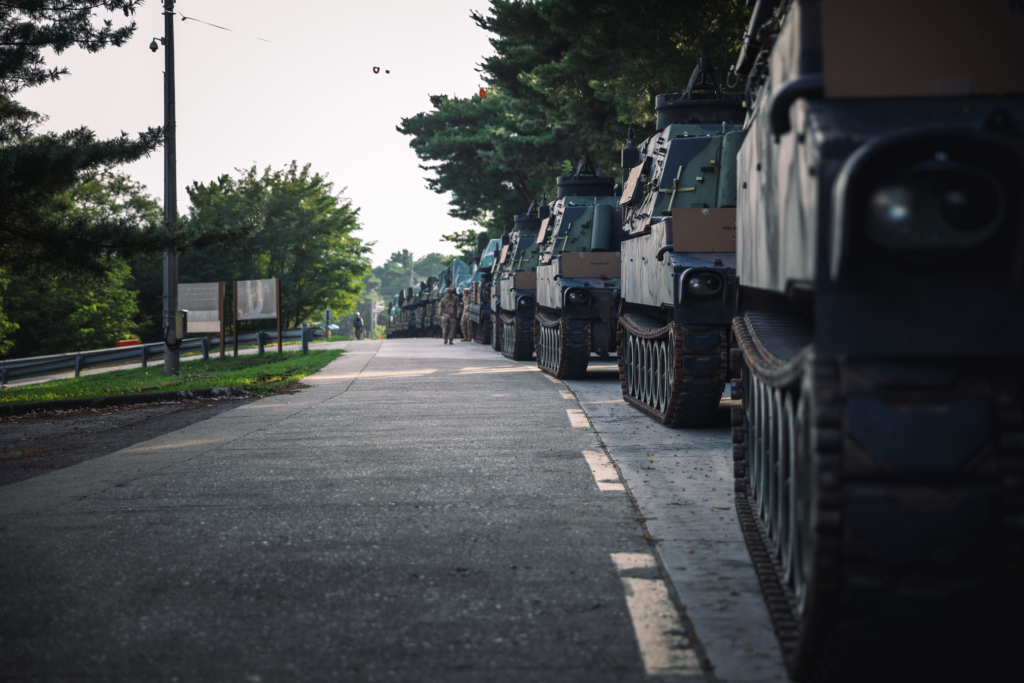The U.S. Army is revising the worldwide distribution of forward-deployed equipment, dubbed preposition stock, as officials weigh its utility and cost, Lt. Gen. Chris Mohan, the acting Army Materiel Command commander, told Defense News.
“There are going to be changes to the [Army Prepositioned Stock] program,” Mohan said in an interview just ahead of the Association of the U.S. Army’s annual conference in Washington.
The effort was designed to stage weapons, vehicles, equipment and supplies at key global locations so forces can rapidly respond to crises. In recent years, the Army has moved from viewing the use of APS kit as a break-glass-in-case-of-emergency situation to regularly dipping into the stocks for major training exercises.
While APS has long been a cornerstone of U.S. power projection, Mohan acknowledged the system must adapt to new strategic realities, particularly as the Pentagon shifts greater focus to the Indo-Pacific theater.
“All that is being worked with the [combatant commands] right now and will be validated back through the Joint Staff, and the [secretary of defense] will approve, just like they approved some of the recent decisions on APS,” Mohan explained.
The Army has taken “a very hard look with our strategic partners like the Defense Logistics Agency and said, ‘Hey, if we all acknowledge that the tyranny of distance doesn’t get any easier from the continental United States into the Pacific theater, well, maybe we need to stock more forward across the [area of operations] north to south, east to west, so that you give flexibility and options for sustainment,’” Maj. Gen. Gavin Gardner, the Army’s 8th Theater Sustainment Command commander, told Defense News in a recent interview.
The Army is also working to increase the amount of “days of supply” across the theater, he added, “so that you’re not instantly going to be out of fuel because we didn’t plan. … We are rapidly increasing the posture across the theater to make sure that we give options to the commander.”
The Army also decided, for example, to move away from its use of prepositioned stocks on ships — called APS afloat — calculating that the vessels might not be operationally effective or sufficient for the service and the joint force’s needs in the Pacific.
Officials have moved one such equipment package to key land locations in the Pacific area, like South Korea, the Philippines and Australia, Gardner said.
“That really covers our northern, central and southern corridors,” Gardner added. “That allows us to now just bring in troops versus having to bring in equipment, which actually allows us to respond much faster to anything from a humanitarian disaster and relief … to any other crisis.”
The service is also going through an assessment of what it calls Total Army Power Projection Equipment Sets, and is considering, for instance, leaving in place some equipment belonging to units located west of the International Date Line.
“That way you’re able to respond more rapidly,” Gardner explained. “We save a little bit on transportation costs, and it allows us to have a much better persistent presence forward, which we think assists with the deterrence that we’ve been asked to do.”
The upcoming National Defense Strategy will shape those decisions, Mohan added. APS plans will align with the strategy when it is officially released, particularly the concept of land-basing in the Info-Pacific, he noted.
Positioning Army stocks in the Indo-Pacific, however, is not as straightforward as in Europe.
“Of course, I have my thoughts of where I want to put things, but it’s mainly from a distribution standpoint and an ability to move it,” Mohan said. “But, but we’ve got to work through a lot of that because INDOPACOM, it’s bilateral relationships. There’s not the alliance like you have with NATO. So that one’s going to be a little bit harder to work through.”
In Europe, NATO has invested heavily in APS infrastructure to support deterrence against Russia and to strengthen readiness across the alliance. Mohan pointed to Poland as the most advanced example.
“The most up-to-date facility we have for APS is in Poland, built by NATO to our specifications,” he said. “And it’s a beautiful facility.”
The effort to reimagine APS in the complex Indo-Pacific region, where nation-by-nation diplomacy substitutes for a NATO-like architecture, has proven to be a tough nut to crack for several presidential administrations.
“We’ve got to get to a sustainable path forward and it’s something we’re challenged with right now,” Mohan said.
Jen Judson is an award-winning journalist covering land warfare for Defense News. She has also worked for Politico and Inside Defense. She holds a Master of Science degree in journalism from Boston University and a Bachelor of Arts degree from Kenyon College.


